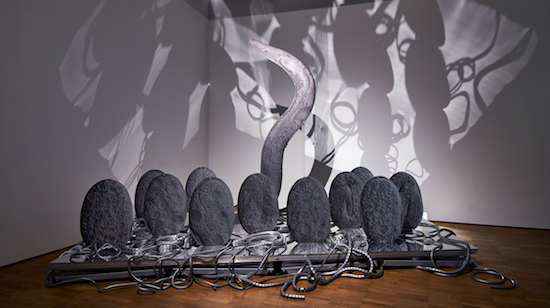The 4Moms Mamaroo is marketed as “the original and ONLY infant seat that replicates [the] natural motions of parents.” Produced since 2010 by Thorley Industries of Pittsburgh, Pennsylvania, and now utilised in over 300 hospitals, the Mamaroo offers five distinct settings – car ride, kangaroo, tree swing, rock a bye, and wave. Designed with the aid of motion-tracking sensors attached to the bodies of real parents in order to closely mimic their natural bouncing and swaying, the simulated movements of the Mamaroo are intended to be as natural, as soothing as possible. But in Katja Novitskova’s current exhibition at the Whitechapel Gallery the device takes on an entirely different cast.
There are four of the things here, all gently bobbing in concert (the selected setting on each is “car ride”), each one appended with chrome screws, plastic studs, and eye-like laser pointers signalling mutely into the darkness of the room. Lit by moving spots from below, like kids with torches telling ghost stories, and soundtracked by eerie, ambient electronic music playing from concealed speakers, Novitskova’s modified Mamaroos appear like bizarre alien incubators, weird robots from some perverse Giger-esque future – which, in a way, I suppose they are.
When social theorists dream of a post-work future, social reproduction and the labour of care inevitably emerge as a stumbling block, a complicating factor. The “moral status we give to certain jobs,” Alex Williams and Nick Srnicek argue in Inventing the Future: Postcapitalism and a World Without Work, amounts to a “final limit of full automation”. It is insufficient, they argue, for a post-work future to make “men freer than ever before to participate in public life, but with women still bound to the household.” When Guardian opinion pieces wring their hands over “robo-care”, it is something like the Mamaroo that they are losing sleep over: a kind of Taylorisation of care, nurture without the nature, rendered cool and eerily inhuman.
“Because I don’t have a television, I watch a lot of YouTube,” Novitskova explained in an interview last year with Paul Laster for Conceptual Fine Arts. “I had been watching a lot of family-bloggers and mom-bloggers documenting their pregnancies. … It was all about going to the mall and getting products, so the videos were like the ten best products during pregnancy or the ten best products after labour – listicle-like videos that share what helps and what doesn’t. One of the things that I saw was this baby swing and I ordered one immediately. I ordered several different versions, with some of them looking like birds. When I got them to the studio I stripped them of all of the baby elements – the toys and the plush seats – so that just the skeletons remained. They are simple machines that just move in different directions, but visually they look half-animal, half-robot – like something that was designed for the military-industrial complex rather than for babies.”
At the same time, there remains something ambiguous in Novitskova’s installation. Beyond John Harris’s horror at the prospect of an incipient invasion of “robo-carers”, Invasion Curves seems to ask, what is a mother, what does it mean to be a mother, and what are the limits of maternity? From the prostheses produced by Thorley Industries to the xenomorph queen from James Cameron’s (1986) flim, Aliens (in some respects, one of cinema’s most enduring and protective images of motherhood), the references on display here stretch at these borders in every direction. After all, as Srnicek and Williams point out, without some kind of engagement with the automation of domestic labour, you could end up with a society in which men are “newly freed from wage labour, but where women continued to be constrained.”
Born in Tallin, in 1984, Novitskova studied semiotics and cultural studies in her native Estonia, at the University of Tartu. Later, studying further first in Germany, at the University of Lübeck, then the Netherlands, at the Sandburg Instituut in Amsterdam, she developed a mobile, agile practice of image production – no studio, just a laptop, PhotoShop, CorelDraw, harvesting vast libraries of found images on the web and collaging them into wild new combinations. In the late 00s she became associated with the post-internet generation of artists, in particular after her book Post-Internet Survival Guide, “a guide,” as the book’s foreword states, “to the ecology of a severe ongoing merging of matter, social and (visual) information in the present world.” In 2017, her installation, If Only You Could See What I’ve Seen with Your Eyes (the title a quote from Bladerunner) filled the Estonian Pavilion at the Venice Biennale, elements from which comprise the present show at the Whitechapel.
Stepping through the big double doors past the Whitechapel’s cloakroom and entering Novitskova’s Invasion Curves installation is like walking onto the set of a science fiction film, slaked through with metallic cabling, flashing lights, giant eggs à la Alien printed flat on aluminium sheets and propped up in clusters, and a slowly rotating image of a human brain projected on the far wall. From the ceiling hang sheets of perspex bearing crude designs – half magical runes, half corporate Power Point presentation – and printed phrases like “the right to harvest resources”, “we are at an inflection point”, and the title “invasion curves” itself. Diaphonous minor chords drift through the space providing a spooky soundtrack. Even the list of materials sounds like a passage from a William Gibson novel: epoxy clay, robotic bugs, cable ties, Swarovski crystals, stress pills, elastic buffers, acrylic massagers, power magnets, silicon stress eggs. This is some cold, hard future we are wandering into.
Katja Novitskova, Invasion Curves, is at the Whitechapel Gallery, London, until 2 September 2018


